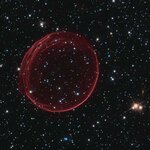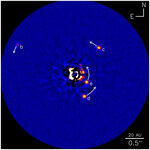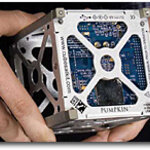Space
If you're in one of the areas of the world blanketed by snow, it probably feels like winter is already here - the cold weather has NPR pundits in such a panic they are claiming the snow is worse than global warming because it means (to them) that the climate is already 'unstable'.
But December 21st is officially winter and it is bringing with it a lunar eclipse. Last time that happened? 1554 A.D., according to NASA.
So enjoy it when it happens. You can see it early in the morning on December 21st across North America, Greenland and Iceland, in Western Europe you will see…

There's an interview of me up on UniverseToday today. Interviewer Nancy Atkinson chose some really nice quotes, which of course make me sound much smarter and more clueful than I really am. So I call it a win! And no one will know better, mwah ha ha. It has my best definition of sonification yet. It also has a cute picture of a cat. So you know the drill, go read it and enjoy!
Alex
Launching Project Calliope, sponsored by Science 2.0, in 2011News every Tuesday at The Satellite Diaries, every Friday at the Daytime Astronomer

SNR B0509-67.5 (or SNR 0509 for short) appears to float serenely in the depths of space, but this apparent calm hides an inner turmoil. The gaseous envelope formed as the expanding blast wave and ejected material from a supernova tore through the nearby interstellar medium. SNR B0509-67.5 is the visible remnant of a powerful stellar explosion in the Large Magellanic Cloud (LMC), a small galaxy about 160 000 light-years from Earth.
Ripples seen in the shell's surface may be caused either by subtle variations in the density of the ambient interstellar gas, or possibly be driven from the…

A new fourth planet (known as HR 8799e) which orbits a bright star called HR 8799 some 129 light years from Earth (faintly visible to the naked eye) has been discovered, making it the fourth giant planet found outside our solar system.
Our four giant planets are Jupiter, Saturn, Uranus and Neptune. Like our solar system, HR 8799 also contains two 'debris belts' composed of small rocky or icy objects, along with lots of tiny dust particles, ours being the asteroid belt between the orbits of Mars and Jupiter and the Kuiper Belt, beyond Neptune's orbit.
The mass of the HR 8799 planetary…

I sat down and started writing a column on Sonification for today, then I realized I'd already written that piece-- several months ago. Whoops.
So instead, I've built an index of the Project Calliope columns by topic, so you can read the full story (so far). This index is current as of Dec 6 2010. Consider it the first half of a DIY satellite builder's guide, plus all the framing material you need to work out your own satellite high concept. Enjoy!
Alex, projectCalliope.com, 'Around the world in 48 beats', reporting weekly on building a music/science satellite in his basement for launch…
While everyone panicked about NASA's arsenic announcement, TechDirt informs us that a TechDirt brings word that "Woman Claims Legal Loophole Means She Now Owns The Sun... And She Wants You To Pay Up". Citing the UK DailyMail and using the same logic that makes Dennis Hope rich with his claim of owning the moon, Angeles Duran claims she's the first to file ownership and thus owns the Sun.
Problems loom for Sun Empress Duran, however. First, a reader claims earlier rights:
I claimed the sun, along with a friend, almost ten years ago using the same loophole. This woman is a…

A satellite as cute as a pumpkin, they are. Ran into this neat post at NASAHackSpace about a Forbes report on Pumpkin Inc's pre-made CubeSats. CubeSat itself is a specification, not a piece of off-the-shelf hardware, so Pumpkin decided to prebuild kits and sell them. If you have your own rocket to launch on, for $7500 they'll sell you a CubeSat kit. Although, to quibble, it looks like they're selling the variant mini CubeSat configuration, rather than the usual 10cm cubes.
This neatly parallels Interorbital's TubeSat-- you know, what I'm building and what this entire…
Small, dim stars known as red dwarfs have turned out to be much more prolific than previously thought, which means that the total number of stars in the universe is likely three times larger than realized.
Red dwarfs are relatively small and dim compared to stars like our Sun, so astronomers haven't been able to detect them in galaxies other than our own Milky Way and its nearest neighbors - so there were only conjectures about how much of the total stellar population of the universe is made up of red dwarfs.
Now astronomers have used powerful instruments on the Keck Observatory in…

MakeZine shows (not just tells, but shows) that
2 square meters of sunlight, focused, will melt anything on Earth
and NASA points out that
The Sun Steals Comets from Other Stars
So I suggest the obvious mashup:
Sun 'Chop Shop' Steals, Melts Comets
Hopefully you can come up with a better title mashup.
AlexTuesdays at The Satellite Diaries and Friday at The Daytime Astronomer (twitter @skyday)

Some of the universe's most massive galaxies may have formed billions of years earlier than current scientific models predict, according to findings in the Astrophysical Journal.
That conclusion was drawn because newly identified galaxies were five to ten times more massive than our own Milky Way. They were among a sample studied at redshift 3≤z4, when the universe was between 1.5 and 2 billion years old.
Redshift refers to the phenomenon of a light wave stretching and moving toward longer wavelengths (the red end of the spectrum) as the emitting object travels away from an…